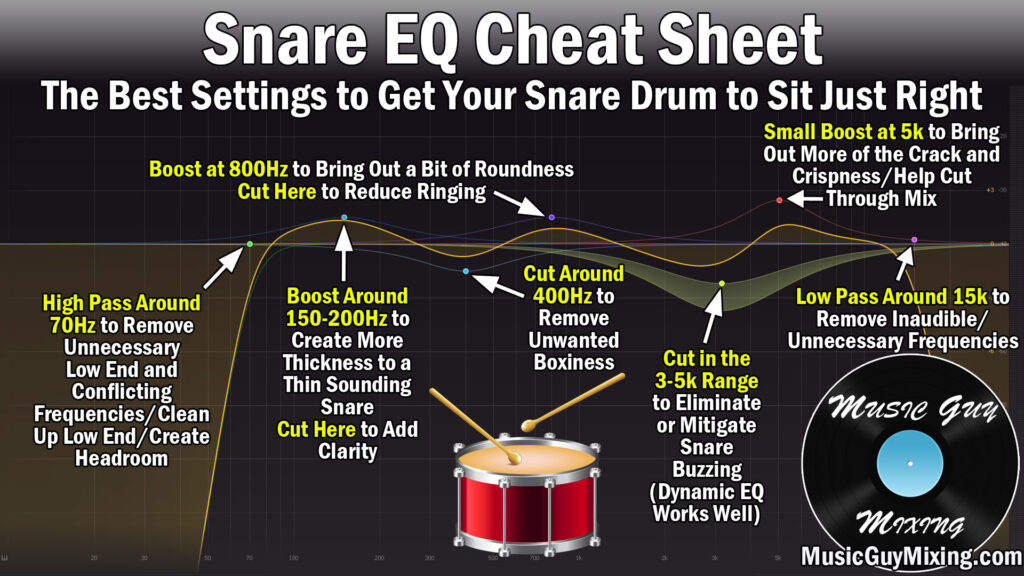After the kick, the snare is a close second to serving as that anchor for your entire mix. In this snare EQ guide, I show the fundamental frequencies for the snare drum and where to boost and cut accordingly. I’ll also be explaining why you should make each cut or boost and the effect they’ll have.
Snare EQ Guide
As I typically say when putting together an EQ guide for a specific instrument, these frequencies will vary slightly every time. Every snare will sound slightly different depending on the sample, the recording, many factors. So keep that in mind as you check out my snare EQ cheat sheet.
Snare EQ Cheat Sheet

Note that I’m using the FabFilter Pro-Q Now as it’s my favorite EQ to dialing in the sounds I want, but these snare EQ recommendations will obviously work with whatever EQ you want to use.
Now let’s talk about each frequency to get more into why I’m recommending these cuts and or boosts in this snare EQ guide.
High Pass Snare at 70Hz to Remove Unwanted Frequencies
Like every other piece in your kit and track in your set, you should high pass your snare.
I use a decent Q here of 30dB/octave for a clean filter.

A good starting point is around 70Hz. Try sweeping up and down from here You can roll this higher, but you start to lose the body of the snare which we’ll cover next.
This will open up space for your kick drum, not to mention clean up the low and create head room.
Boost or Cut at 150-200Hz for Body or Adding Clarity
The thick body of the snare resides in the 150-200Hz area.

We can use this frequency range to shape the tone we want out of our snare or correct an issue.
If the snare is sounding too thin or needs more body, try boosting here.
If it’s too cloudy or muddy sounding and you need some clarity, cut here before boosting the higher frequencies. Incidentally, check out my guide on the 5 causes of a muddy mix as I show how to clean up your mix.
Cut At 400Hz for Boxiness
The 400Hz area typically causes a flat, boring, boxy sound on snares.

Try a small cut here to add some clarity to your snare, as well.
Boost or Cut at 800 Hz for Roundness or Ringing
800Hz on a snare is an interesting area which can yield a couple different results.

If you have an annoying ringing sound on your snare, cut here to reduce the severity or remove it altogether if the ringing isn’t too bad.
Conversely, a boost at 800Hz can yield a fuller, rounded snare sound which might be what you’re missing. It really depends on the source material, so experiment.
Cut at 4k to Remove Buzz
If you have snare buzz, try a cut in the 3-5k region.

I like a dynamic EQ cut here which adjusts depending on how prominent the problem is.
We don’t want to hack away in this area as we’re just getting into the crispness of the snare which helps it cut through the mix.
Boost at 5k for Transients
Speaking of that crispness, 5k on a snare represents the stick on skin sound.

This “crack” is the frequency which helps the snare cut through the mix.
With that in mind, consider giving it a boost to help the listener lock on to those transients especially in a busier mix.
Low Pass Around 15k
As always, be sure to low pass, cutting everything out starting around 15k.

Going lower than this creates more room for the cymbals and vocals, but it also eats into the openness of the snare and the previously mentioned crack.
15k is a nice compromise to open the frequencies above it for more important instruments while maintaining the transient integrity of the snare.
Snare EQ Tips
- The snare is one of the most important instruments in your mix to get right.
- Snare EQ can help you sculpt your tone or correct problems.
- High pass around 70Hz as a rough starting point to remove unwanted frequencies while keeping body.
- Boost or cut at 150-200Hz to add body or clarity, respectively.
- Cut around 400Hz to remove boxiness on snare.
- Boost or Cut at 800Hz to add roundness or reduce ringing, respectively.
- Cut conservatively in the 3-5k range to mitigate snare buzz.
- Boost at 5k to add transients of the crack of stick on skin.
- Low pass around 15k to preserve transients but remove unnecessary frequencies.

Pingback: LCR Mixing - An Easy Way to Create Pro Mixes - Music Guy Mixing